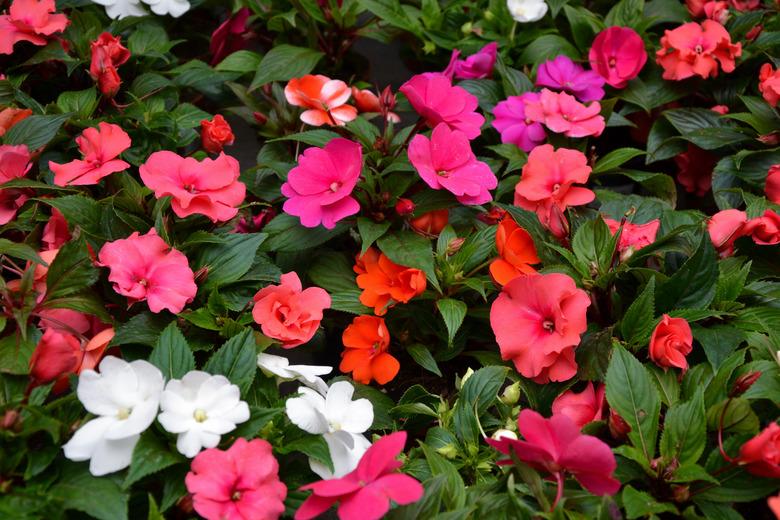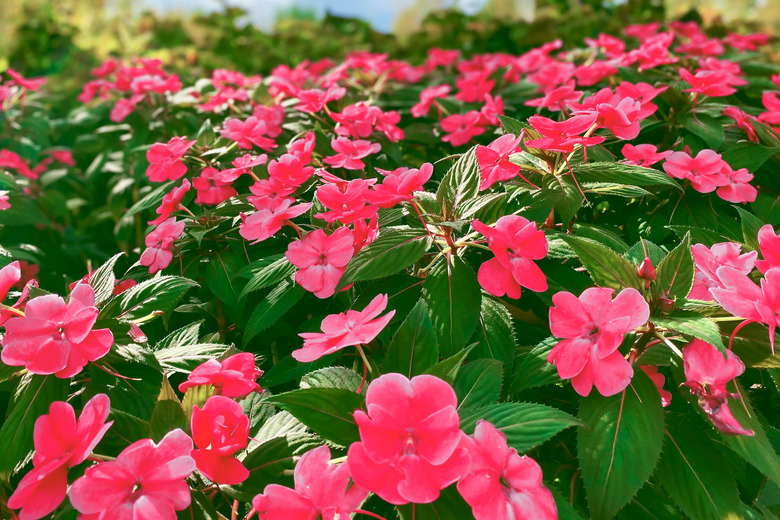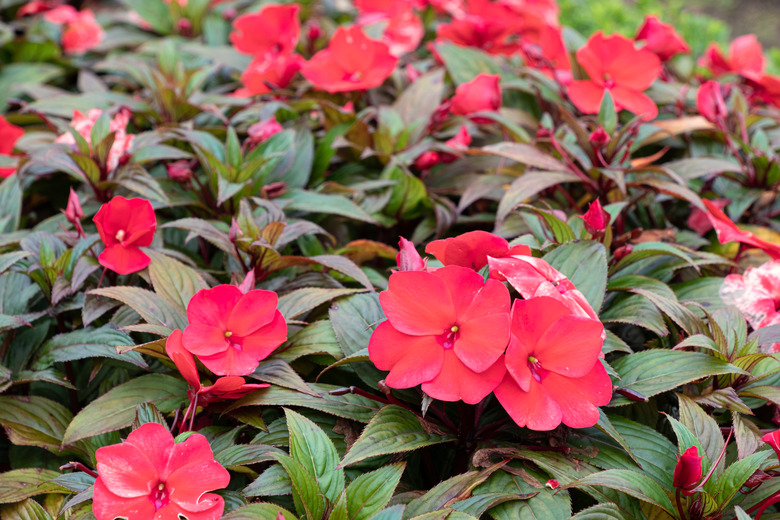How To Grow Impatiens
We may receive a commission on purchases made from links.
Impatiens (Impatiens spp.) are colorful annual flowers that just keep going all summer long. Although there are numerous species of impatiens, each with its own merits, the ubiquitous "busy Lizzy" (Impatiens walleriana) has been a bedding favorite of gardeners for generations. They love the shade and often grow where not much else will, but they'll also tolerate a bit of sunlight if you're diligent about watering them. They do require regular irrigation, but impatiens need little else from their garden keepers.
Available in almost every imaginable color, impatiens bloom red, magenta, white, salmon and quite a few shades in between, including bicolor flowers. They lend a homey, cottage feel to the garden, allowing you to mix and match colors or stick with your favorite hue for a more dressed-up appearance.
Best Uses for Impatiens
Best Uses for Impatiens
Impatiens plants are incredibly versatile plants that work well throughout the landscape. You can use them as border plants or to fill and accent flower beds. They're perfect for filling garden gaps like a ground cover, and they love the shade, so you can use them for a stunning pop of color even if your outdoor space lacks direct sunlight.
Impatiens also thrive in containers and work with other annuals in planters and window boxes. Many gardeners grow impatiens in hanging baskets. They keep blooming all summer long and don't require deadheading, so you can even use them to add color in hard-to-reach areas of your garden where high-maintenance plants are a curse rather than a blessing.
How to Grow Impatiens
How to Grow Impatiens
Starting Impatiens From Seed
Impatiens are extremely popular with gardeners, and young plants are incredibly easy to find in the spring. Impatiens can also be grown from seed. The only downside to starting with seeds is that you'll have to wait a little longer to enjoy your plant's blooms, but starting impatiens indoors can shorten the delay.
- Start your seeds indoors eight to 10 weeks before your area's last expected frost.
- Fill your seed trays with fresh potting soil and sow the seeds about 1/8 inch deep.
- Water the seeds gently and place them in a well-lit area where the soil temperature will stay at a consistent 75 degrees Fahrenheit.
- If necessary, use a heated seed mat to keep the soil temperature where you need it to be.
- Seeds typically germinate in five to seven days. Your young seedlings are ready to transplant when they reach 3 to 4 inches tall. Wait until after the last frost, however, to plant them outside.
Starting Impatiens From Transplants
Bedding plants purchased at the garden center in the spring are an excellent way to add immediate color to your outdoor space. Before you plant, mix a slow-release 10-10-10 fertilizer into your soil. Use about 1/2 cup of fertilizer per 100 square feet of soil. This will nourish your impatiens all season.
- Dig planting holes just wide and deep enough to cover the entire root ball of your new plant. If you want your plants to grow out rather than up, space them at least 8 to 12 inches apart. For plants that grow up rather than out, place impatiens closer together, planting them as little as 2 inches apart.
- Water your new plants immediately after you transplant them and mulch around them to help keep the soil moist. Impatiens can dry out quite quickly, so don't skip the mulch.
In What Zone Do Impatiens Grow Best?
In What Zone Do Impatiens Grow Best?
Impatiens are tenacious plants and grow well as annuals almost anywhere in the United States. Even in zone 2, where there are only about 90 frost-free days, impatiens will flourish during the little time they have to bloom. In zones 10, 11 and 12, impatiens are perennials.
When Should You Plant Impatiens?
When Should You Plant Impatiens?
For maximum enjoyment, plant impatiens as early as you can in the spring. As long as the soil temperature is at least 75 degrees, your plants will do well.
If you see a plant that catches your eye during a summer stroll through the garden center, don't hesitate to purchase and plant it. Your plant may need a bit more water if planted in the summer rather than spring, but it should take root without issue. Later planting gives you less time to enjoy your impatiens before winter, but it won't harm the plant.
Soil, Sunlight and Water Recommendations for Impatiens
Soil, Sunlight and Water Recommendations for Impatiens
Impatiens like a loamy, pH-neutral soil that sits in a shady spot. They grow best when they receive about four hours of dappled sunlight a day. Impatiens will grow in deep shade, but they tend to get taller and produce fewer flowers. They'll also tolerate some direct sunlight but need lots of water to do so.
In fact, impatiens tend to need a lot of water overall. As is true of all plants, impatiens planted in containers need more water than those planted in the ground. If you've planted your impatiens in a container, expect them to need daily watering (or every other day) during the extreme heat of summer.
In the ground, impatiens need a minimum of 2 inches of water per week. Increase their water intake to 4 inches per week at temperatures of 85 degrees and above. Impatiens wilt quickly without adequate water, and their droopy appearance will let you know that they need more irrigation. They aren't bashful about asking for water.
Although it can feel like your impatiens need constant watering during a hot summer, these fairly independent plants need little else. There is no need to deadhead the flowers, which do an excellent job of cleaning up after themselves. Your plant will eject spent flowers and produce new ones rapidly without assistance, blooming continuously until it's killed by frost.
Adding some fertilizer to the soil when planting your impatiens is generally enough to see them through the growing season. If you think your plants could use a bit more, however, you can fertilize them a second time halfway through the growing season. Use the same fertilizer you mixed into the soil when you planted them.
Common Pests and Other Problems for Impatiens
Common Pests and Other Problems for Impatiens
Unfortunately, any gardener may find these plants hosting spider mites and aphids. Although you may not see the pests themselves, spider mites leave behind a weblike substance that you'll notice on your plants. Appearing as small greenish-yellow dots, aphids are visible on plants and leave behind sticky leaves. A blast of water from your hose will scatter both aphids and spider mites. Avoid using insecticidal soap, which can damage impatiens.
Whiteflies aren't truly flies, but they do look like tiny white flies when they're crawling around on your impatiens. They often gather on the underside of leaves, and like aphids, they leave behind a sticky residue.
Because they don't do well in cold weather, whiteflies are typically a problem only for gardeners in zones 7 and warmer. They can, however, overwinter in greenhouses further north. Fortunately, like aphids and spider mites, whiteflies are easily knocked from plants with water.
Caterpillars also sometimes visit impatiens but are generally not problematic. If you see them on your plants, you can easily pluck them off. A sprinkling of diatomaceous earth around the plants will also keep caterpillars at bay.
Common Diseases for Impatiens
Common Diseases for Impatiens
Unfortunately, impatiens are quite susceptible to downy mildew. The disease can prove devastating for infected plants, first causing the plant's leaves to turn yellow and curl up. As the disease progresses, white fuzzy growth appears on the plant, blooms will fall away and bare spots lacking both foliage and flowers will remain. Problems usually begin to appear late in the summer.
Commercial growers are aware of the downy mildew problem in impatiens and have worked hard to produce many disease-resistant cultivars. You can also help prevent the disease by watering your plants using soaker hoses rather than overhead watering methods and keeping the garden free of fallen leaves and plant debris. You should also avoid planting impatiens in areas of the garden where downy mildew has been a problem before. Unfortunately, there is no cure if downy mildew strikes. All you can do is remove and destroy diseased plants quickly before the problem spreads.
Impatiens can also fall prey to a variety of fungal leaf spot diseases and gray mold. Gray mold tends to affect damaged or wounded plants, so handle your plants gently when working with them and around them. Gray mold starts as leaf spots that look water-soaked and eventually turn brown. As the disease progresses, grayish webbing will cover the plant.
You can usually treat leaf spots successfully with a fungicide. Gray mold is harder to treat. Usually, the best plan is to remove plants affected by gray mold and then treat the remaining plants as a precaution.


